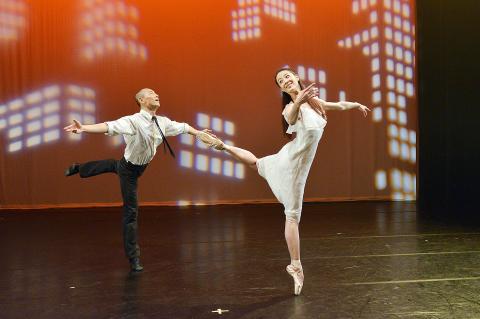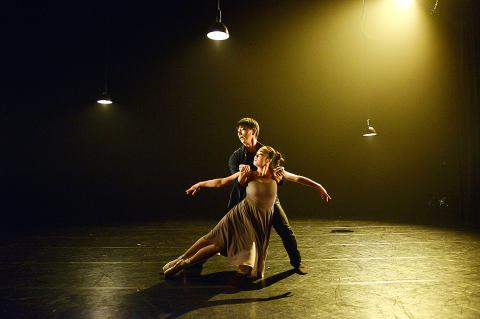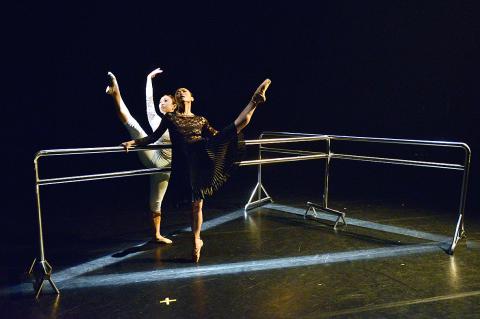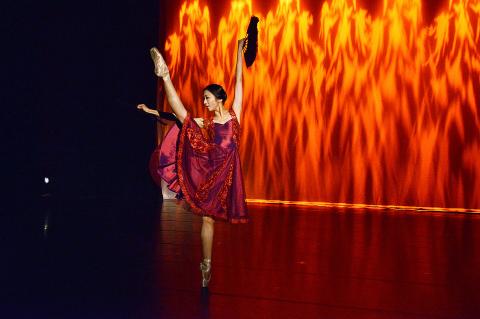Scheduling problems have kept the Kaohsiung City Ballet (KCB, 高雄城市芭蕾舞團) from making its almost annual pilgrimage north to Taipei with its Dance Shoe (點子鞋) production, which is a loss for Taipei ballet fans, given the caliber of last year’s show.
Company founder Chang Hsiu-ru (張秀如) could not get her troupe into the Experimental Theater before the venue closed for its annual Lunar New Year renovation and clean-up period, and so had to settle for two-city tour.
KCB premiered this year’s Dance Shoe in Greater Tainan two weekends ago and this weekend it returns to its “home theater,” Chihteh Hall at the Kaohsiung Cultural Center, for two shows.

Photo Courtesy of Liu Ren-haur
This 12th version of Dance Shoe features works by four Taiwanese choreographers and one foreign freelancer, all of whom will be familiar names for the company’s fans.
The local choreographers, in keeping with Chang’s desire to showcase southern talent, are either all from southern Taiwan or now work there.
Tsai Po-chen (蔡博丞), who has had pieces in several earlier shows, created the stellar Little Star (小小星辰) last year, while Wang Wei-ming (王維銘), a former Cloud Gate dancer who now teaches at Shu-Te University in Greater Kaohsiung, had a piece in last year and in 2013. Lai Hung-chung (賴翃中) and Dai Ting-ru (戴鼎如), a dancer with the company who is now working on a graduate degree in Taipei, have also contributed in the past.

Photo Courtesy of Liu Ren-haur
Chang hired Romanian dancer-choreographer-videographer Constantin Georgescu to restage the full-length ballet Coppelia (柯碧莉亞) for the company to perform in the Kaohsiung Spring Festival last year and her dancers responded well to the challenge. For this year’s Dance Shoe he has created a work titled Ladies and Fans.
The chance to work with such a variety of choreographers provides valuable experience for Chang’s dancers as well as providing dance audiences a chance to see a combination of modern and classical technique in one setting.
While some dance fans, this reviewer included, are heading south this weekend to see the shows, Chang and the KCB will hopefully be able to return to Taipei with next year’s Dance Shoe.

Photo Courtesy of Liu Ren-haur

Photo Courtesy of Liu Ren-haur

April 14 to April 20 In March 1947, Sising Katadrepan urged the government to drop the “high mountain people” (高山族) designation for Indigenous Taiwanese and refer to them as “Taiwan people” (台灣族). He considered the term derogatory, arguing that it made them sound like animals. The Taiwan Provincial Government agreed to stop using the term, stating that Indigenous Taiwanese suffered all sorts of discrimination and oppression under the Japanese and were forced to live in the mountains as outsiders to society. Now, under the new regime, they would be seen as equals, thus they should be henceforth

Last week, the the National Immigration Agency (NIA) told the legislature that more than 10,000 naturalized Taiwanese citizens from the People’s Republic of China (PRC) risked having their citizenship revoked if they failed to provide proof that they had renounced their Chinese household registration within the next three months. Renunciation is required under the Act Governing Relations Between the People of the Taiwan Area and the Mainland Area (臺灣地區與大陸地區人民關係條例), as amended in 2004, though it was only a legal requirement after 2000. Prior to that, it had been only an administrative requirement since the Nationality Act (國籍法) was established in

With over 80 works on display, this is Louise Bourgeois’ first solo show in Taiwan. Visitors are invited to traverse her world of love and hate, vengeance and acceptance, trauma and reconciliation. Dominating the entrance, the nine-foot-tall Crouching Spider (2003) greets visitors. The creature looms behind the glass facade, symbolic protector and gatekeeper to the intimate journey ahead. Bourgeois, best known for her giant spider sculptures, is one of the most influential artist of the twentieth century. Blending vulnerability and defiance through themes of sexuality, trauma and identity, her work reshaped the landscape of contemporary art with fearless honesty. “People are influenced by

The remains of this Japanese-era trail designed to protect the camphor industry make for a scenic day-hike, a fascinating overnight hike or a challenging multi-day adventure Maolin District (茂林) in Kaohsiung is well known for beautiful roadside scenery, waterfalls, the annual butterfly migration and indigenous culture. A lesser known but worthwhile destination here lies along the very top of the valley: the Liugui Security Path (六龜警備道). This relic of the Japanese era once isolated the Maolin valley from the outside world but now serves to draw tourists in. The path originally ran for about 50km, but not all of this trail is still easily walkable. The nicest section for a simple day hike is the heavily trafficked southern section above Maolin and Wanshan (萬山) villages. Remains of